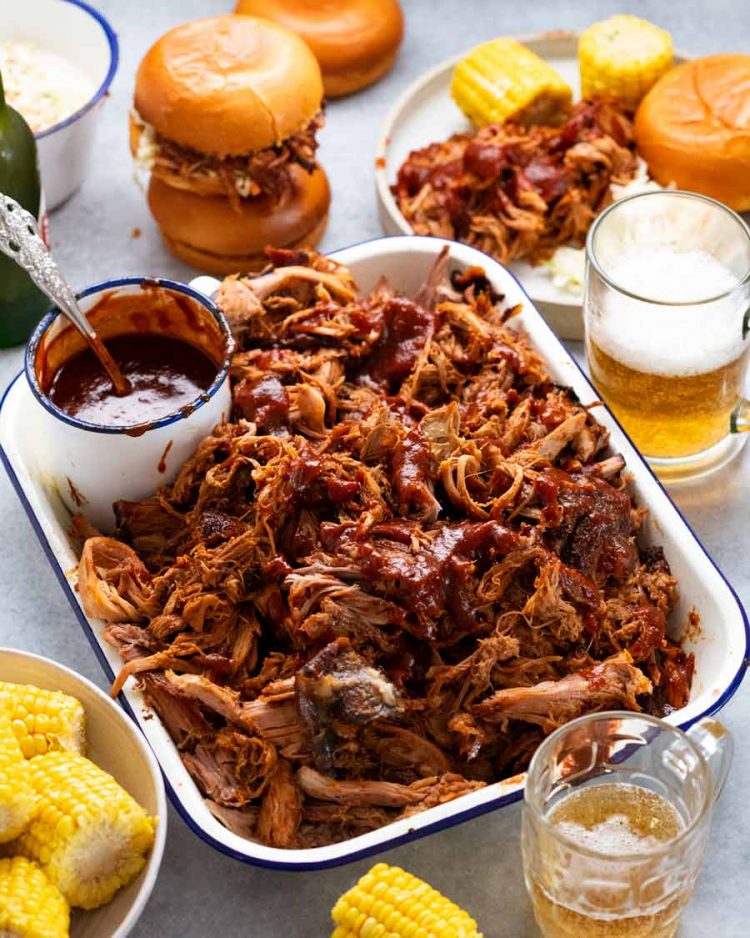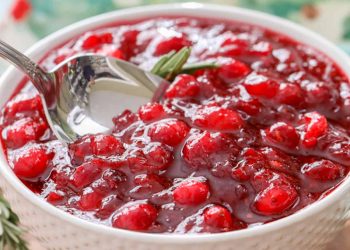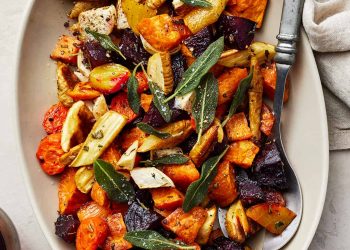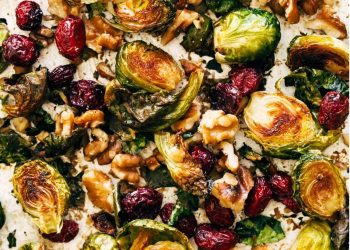This is my Rolls Royce of Pulled Pork recipes. A 24-hour brine injects flavour and locks in juices, then a 12-hour oven slow roast makes the pork more succulent than you ever imagined it could be!
Don’t have time for this version? I get it. Make my Slow Cooker Pulled Pork instead!
My best pulled pork shown with BBQ sauce (recipe below), corn bread muffins, coleslaw and ice cold beer!
36-hour Pulled Pork
That’s right, 36 hours is what it takes to make my very best Pulled Pork recipe: A 24-hour dry-brine in a heavily-flavoured rub, followed by a 12-hour slow roast in the oven.
I would not share a 36-hour recipe though if I was not 100% sure it produces the very best results! I can assure you it really does, and the reasons are simple:
Brining overnight locks in juices and injects flavour all the way through the pork so every mouthful of pork is seasoned; and
Slow-roasting at a very low temperature means less moisture loss and in turn more succulent meat.
Cooking in this way also gets you that desirable “bark” on the surface that people love about traditional BBQ food. It’s my favourite part. It’s so tempting to lift the whole thing off and run away with it!
Check out the proof of epic bark:
Close up look at the terrific bark on this Pulled Pork recipe. You can’t achieve this same quality bark using a slow cooker, we need the oven. Long and slow!
And proof of ultra-tender, juicy meat:
Every strand of pork is seasoned thanks to the overnight brine.
My typical 36-hour Pulled Pork timeline
Here’s my basic game plan with timings to help you ensure your pork is ready for when you want to serve it, for either lunch or dinner.
2 days prior, anytime (usually evening) – Coat pork in rub and leave to brine/marinate for 24 to 48 hours in the fridge.
Evening before serving – Put pork in oven to slow-roast overnight.
Next morning (day of serving) – Remove pork from oven. Keep whole until required. Shred pork as close as possible to serving time, for optimum juiciness.
If serving for lunch – Time the cooking to finish within 2 hours of serving so the pork stays warm, and no need to reheat.
If serving for dinner (reheating whole pork) – Allow pork to fully cool on the counter, uncovered (if you cover, bark will go soggy). When cool, cover and refrigerate.
Remove from fridge 3 hours prior, leave on counter for 1 hour. Then cover loosely with foil and reheat in a 150°C/300°F oven for 2 hours or until the centre is hot, then shred as close as possible to serving time.
Microwave emergency – If you forgot to allow for reheating, you can microwave it uncovered in an emergency. It actually works well because it keeps the meat juicy!
What you need to make my best Pulled Pork
Here’s what you need for the Pulled Pork:
Pork butt / Boston butt (4 – 5 kg / 8 – 10 lb) – Also known as “butcher’s block” or “square cut shoulder of pork” in Australia, this is a big rectangular block of pork from the of the upper pork shoulder (not its butt!) It’s best for Pulled Pork because it’s well marbled and a uniform shape. It comes with a layer of fat on the surface, no skin (in Australia), and a bone inside.
Where to find it – Though widely available and very good value in the US, here in Australia it’s not available at everyday supermarkets. However, it IS sold at Costco! Otherwise, find it at good butchers.
What to ask for – Pork butt / Boston butt / butcher’s block / square cut pork shoulder. Describe it as a 4 to 5 kg rectangular block of pork shoulder. Insist / ask politely that it be bone-in, skinless, with some but not all the fat removed from the surface.
Best substitute – Regular pork shoulder works but it will need to be a minimum of 3 kg / 6 lb (including the bone). If it’s too small it will cook too fast and defeat the purpose of the 12-hour slow roasting that yields the ultra-juiciness of the meat. Usually here in Australia, pork shoulder is only about 2 – 2.5 kg / 4 – 5 lb (once the skin is removed).
Beer – This has multiple purposes. It’s used as (1) the liquid in the pan to prevent the pan from drying out during the slow-roasting, (2) for extra flavour on the pork flesh, and (3) making tasty pan juices which are later tossed through the shredded pork and stirred into the homemade BBQ sauce.
Beer type – You can use any beer other than very dark beers like Guinness. Dark beers can be a bit too intense and dominate the pan juice flavours.
Substitute with alcoholic apple cider (dry/hard cider), non-alcoholic beer or apple juice, which I’ve used in the past for similar recipes to great success (like BBQ pork ribs).
Rub ingredients – The sugar, salt, pepper and spices you see in the photo above are all for the rub. The seasonings (a good number from my 12 Essential Spices list!!) are for flavour, while the salt dry-brines the pork to make it juicier.
What is dry-brining? Brining exploits the effect of salt on muscle fibres so meat retains more moisture as it cooks. As a handy bonus, it also fully seasons the meat on the inside – great for large cuts like pork butt. Dry-brining is a type of brining where no water is used, just salt (contrasted with wet-brining where you soak protein in salted water). We get the same effects (juiciness and seasoning) except it’s even better because the flesh isn’t bloated with flavourless water, which dilutes meat’s flavour. It’s also convenient because you don’t have to deal with the logistics of keeping a giant piece of pork submerged in liquid in the fridge.
Bottom line: Dry-brining works better and is easier. It’s how I do my turkey every year. Dry brine, dry brine, I say!
How much pork do you need per person?
To figure out how many people your pork will serve, multiply each kilo of raw pork by 3 to get normal servings or by 2.4 for generous servings. Imperial measurements: Multiply each lb of pork weight by 1.5 for normal servings or 1.2 for large servings.
Example:
It might sound like a lot of pork per person (335g – 410g / 11 – 14 oz) but remember, pork loses about 40% of its weight once cooked!
What you need for homemade BBQ Sauce
Nothing groundbreaking here! All the usual classic BBQ sauce suspects are present:
Ketchup – The key ingredient in BBQ sauce. I know it’s totally un-Australian of me to say, but I really prefer ketchup over tomato sauce. Better flavour. Sorry Australia!! Best substitute – Well, tomato sauce!
Apple cider vinegar – For the tang in BBQ sauce. Substitute with white or red wine vinegar.
Molasses (light/true molasses, NOT blackstrap) – Adds sweetness, colour, gloss and flavour. Easy substitute: golden syrup!
Worcestershire sauce – For savoury flavour.
Tabasco – Optional, for a hit of heat!
Sugar – BBQ sauce is sweet, tangy and a bit savoury. This helps with the sweetness!
Mustard and garlic powder – The savoury seasonings. I prefer powdered garlic over fresh garlic, and powdered mustard over mustard spread because the powder versions have a more earthy flavour that I think works better for BBQ sauce.
How to make my best Pulled Pork
It might take 36 hours all up, but it’s actually very straight forward as a process. Also, the brining step, though recommended for truly the best results, can actually be skipped if you want. You still get plenty of flavour on the bark that gets mixed through the meat, as well as in the roasting pan juices that we toss through the meat. The BBQ sauce also adds a good load of flavour!
1. Brining
As mentioned above, a 24-hour dry brine locks in the juices as well as seasoning the flesh right to the middle of that considerable hunk of meat!
Rub – Mix the rub ingredients in a small bowl.
Coat the pork all over with the rub and use your hands to …well, rub it in. 😂 Get right into all those cracks and crevices. Yep, I know some people hate it / laugh when I write that, and I write it every time I use a rub. Have a giggle and rub away!!!
Get as much rub as possible to stick to the pork, being particularly generous on the top. You will end up with some excess rub loose on the tray, as you can see in the photo above. That’s OK.
Brine 24 hours – Position the pork fat side up (smoother side). Place the pork UNCOVERED in the fridge overnight. Uncovered is best because that way your pork will not sweat under cling wrap or similar. It also dries out the surface of the pork which is key to the best bark!!!
Can I brine for longer? Yep! I’ve done it for up to 48 hours. I actually didn’t notice a difference between 24 hours and 48 hours however, so there’s no additional benefit to brining for longer. More that if you forgot or the timing suits you, it’s no issue.
Post-brining – This photo shows what it looks like after brining. There will be some liquid in the pan, which is a bit of pork juices mixed with dissolved salt. Discard this liquid when transferring the pork to the roasting pan. We only want whatever stuff sticks to the pork.
2. 12-hour slow-roasting
Liquids for cooking – Transfer the pork into a roasting pan. Then pour the beer and water around it, using additional water to top up as needed so that the liquid level is 2.5 cm / 1″. This is to ensure the pan doesn’t dry out during the slow roasting time. It means the pork will be even juicier (nice and steamy environment!) as well as ensuring we end up with some roasting pan juices that we toss through the pork at the end + stir into the BBQ sauce (it’s free flavour!).
Slow roast the pork uncovered for 12 hours at 110°C/230°F (both fan-forced and standard). Some notes on the slow cooking part:
a) Low temperature – We want to use lowest temperature possible to cook this pork at because the lower the temperature, the less moistures is lost from the flesh of the pork which in turn means juicier pork meat. I found that 110°C/230°F is the minimum temperature for the middle of the pork to peak at 95°C. At this temperature, the meat will be tender enough to shred with no effort. Cooking at a temperature lower than 110°C/230°F, I found the pork never became “fall-apart-at-a-touch”.
b) Uncovered – The pork is cooked uncovered so we get that desirable, intensely-flavoured bark on the surface all over the pork. This part is everyone’s favourite!
c) Overnight roasting – At such a low temperature and with the amount of liquid we put in the pan, I feel perfectly safe sleeping with the oven on. It’s also super-handy to do the slow-roasting overnight because it’s entirely hands-off. The cooked pork reheats perfectly so I can serve it anytime the next day.
d) ⚠️ OVEN AUTO-OFF – Many ovens, including mine, will automatically turn off after 12 hours. This is for safety reasons. So be sure to check if yours has an auto-off function (check the manual)! If it does, firstly preheat the oven, put the pork in then turn it off. Immediately turn it back on (to restart the 12-hr clock, so to speak). Now you’re good to go. Also, how handy that your oven will now turn itself off bang on 12 hours when your pork is ready!
Slow-roasted pork – After 12 hours, the pork should be fall-apart-tender with a thick, almost black crust. Pick a bit off and have a nibble – cooks’ treat!
There should still be some liquid remaining in the pan. How much depends on a lot of things, like the size of your pork, your oven and so on, but usually there is around 1.5 – 2 cm / 3/4″ of liquid.
Transfer the pork to a different pan, large enough for shredding. Rest the meat for 20 minutes before shredding. Just because we slow-cooked the meat does not mean we can skip the essential step of resting the meat! During this time juices inside the meat are reabsorbed back into the meat fibres = juicier!!
Shredding
We come to the best part – because you get to pick and nibble throughout the whole process!
Shred the pork using two forks or tongs. It’s so tender it will be effortless! Shred into strand sizes you desire. Some people like superfine, others like chunks. I’m sort of in-between.
Pan juices and BBQ sauce – Pour over some roasting pan juices (it’s got tons of flavour, we are NOT wasting it!) and some BBQ sauce. Just enough of both to juice up the meat a bit, not drown it! I prefer to serve BBQ sauce on the side so people can use as much or as little as they want.
Toss well.
Serve – Now serve with remaining BBQ sauce on the side! Pictured above with soft buns and coleslaw, to make Pulled Pork Sandwiches. YESSS!!!! (Some more serving suggestions below).
Homemade BBQ Sauce
Just briefly, the BBQ sauce. It’s a plonk-and-stir, simmer-for-45-minutes job. Very easy! It can be made at any time that suits you as it keeps and reheats perfectly.
Honestly, that sight … a big pan of juicy meat that’s had my love and attention for the last 36 hours … (albeit I’ve been asleep for most of that time, but that’s not the point!)… now THIS is my kind of food.
I know this is totally un-lady like. I’m not the dainty sort, not in my food choices, nor in how I barrel through life. But boy does it make for a tasty life!!!
Case in point, Pulled Pork Sandwiches, dripping with pork juices mingling with BBQ sauce. Oh and look, Coleslaw joining the party too:
Or, try a big Southern dinner spread by adding classic sides that you’d swear were invented just to serve alongside Pulled Pork!
Great Southern sides to serve with Pulled Pork
As for dessert? Try one of these!
Desserts. Because we ALWAYS have room for dessert!
So, have I convinced you it’s time for a BIG PULLED PORK feast this weekend? Oh, not this weekend? So – next weekend?? 😉 – Nagi x
12 hour roast not for you? I get it. Try my easy Slow Cooker Pulled Pork instead. Long standing reader favourite!
Watch how to make it
Hungry for more? Subscribe to my newsletter and follow along on Facebook, Pinterest and Instagram for all of the latest updates.
My best Pulled Pork
Prep: 15 mins
Cook: 12 hrs
Brining: 1 d
Mains
Southern
Servings15 – 20 people
Tap or hover to scale
Recipe video above. This takes 36 hours to make – but it’s worth it. A 24-hour dry brine seasons the pork all the way through, followed by slow-roasting for 12 hours at a really low temperature. I would not tell you to roast a pork for 12 whole hours if I was not 100% sure that this produces the very best results! It really does, and the reason is simple: lower heat means less moisture loss which means more succulent meat. Plus, a great bark on the surface that everybody loves about traditional BBQ food. It’s my favourite part!
Instructions
Dry brine overnight (Note 7) – Pat the pork dry and place in a large ceramic dish. Mix Brine ingredients in a small bowl and rub it all over the pork, being sure to get into the cracks and crevices. Turn it fat side up (smoother side) covered with as much rub as possible. Refrigerate uncovered for 24 hours.
Preheat oven to 110°C (both fan-forced and standard) / 230°F.
Prepare for roasting – Transfer pork to a roasting pan (do not wipe the rub off) with the fat side up. Discard any liquid and residual rub left in the brining dish. Pour beer and water around the pork, topping up with extra water as needed so the liquid level is 2.5 cm / 1″ (insurance against pan going dry).
Slow roast 12 hours (Note 8) – Roast, uncovered, for 12 hours, or until the internal temperature reaches 95°C/203°F and the meat falls apart effortlessly using two forks. ⚠️ Make sure your oven does not automatically turn off mid cook, many have auto-off functions that kick in at 12 hours (also factor in oven pre-heating time)!
Shred – Transfer the pork to a large pan (reserve juices in roasting pan). Rest for 20 minutes then shred with tongs / forks – it will be effortless! You can discard the fat cap at this stage if you want. I leave some, it makes the shredded pork even juicier.
Sauce it – Pour 3/4 cup of the juices from the roasting pan and 1 cup of Barbecue Sauce (see below) over the pork, and toss.
- Serve Pulled Pork with remaining Barbecue Sauce on the side so people can help themselves. Either make a big Southern feast with a side of cornbread, coleslaw and potato salad or macaroni salad. Or make Pulled Pork buns with soft rolls stuffed with coleslaw, Pulled Pork and the BBQ sauce!
Barbecue sauce:
Place ingredients in a large saucepan and whisk to combine.
Simmer 45 minutes: Bring to simmer on medium heat, then reduce to a low simmer for 45 minutes. Stir occasionally.
Add pork juices: When the pork is cooked, add 1/2 cup of the juices from the roasting pan into the BBQ sauce and simmer for 5 minutes. Use water to control thickness – it should have a thick syrupy consistency. Serve warm or at room temperature (not fridge cold).
Recipe Notes:
1. Pork – Known as pork butt, Boston Butt or “pork square cut shoulder”, this is a big rectangle block of pork that is part of the upper pork shoulder. Best for Pulled Pork because it’s well-marbled and a uniform shape. Comes with a layer of fat on the surface, no skin, with a bone inside. Find it at butchers, not yet widely available in Australian grocery stores. Best substitute is a regular pork shoulder but it will need to be a minimum of 3 kg else it will cook too fast!
2. Beer – Any beer other than really dark ones like stout and Guinness can be used. Substitute with apple cider or apple juice.
3. Rub spice substitutions:
- Garlic powder and onion powder – substitute with more of the other
- Mustard powder – same amount of dijon mustard spread
- Oregano leaves – omit
- Brown sugar – white sugar or honey
4. Cooking/kosher salt have larger grains than table salt so it works best here for more even penetration into the meat for brining. If you only have table salt, use 2/3 of the quantity called for in the recipe.
5. Apple cider vinegar – Sub with white or red wine vinegar.
6. Molasses – Be sure not to use BLACKSTRAP molasses which is very dark, intensely-flavoured and bitter. Australia, DO NOT get Blue Label Molasses from Coles, if you read the label carefully you will see it is blackstrap. I use Mountain Valley Molasses from Wooloworths. Save leftovers for Gingerbread men!
7. Dry brining – Seasons the pork flesh all the way through and makes pork even juicier. While it’s highly recommended for best results, you can skip it in the event of a pork emergency (it happens, I understand).
8. Slow roasting – Read post for why this yields the best result.
Timing – I typically do the slow-roast overnight. With the very low oven temperature, the beer plus the juices that come out of the pork (a LOT!) to prevent the pan from scorching, I am not concerned about sleeping with the oven on.
To serve for lunch – Start late the night before last to serve for lunch tomorrow. The cooked pork will stay warm for a good 2 hours. Best to shred close to serving time.
To serve for dinner – Make the whole pork ahead then reheat when needed. It reheats 100% perfectly because it’s so juicy from the slow-roasting. See ‘Make ahead’ section below.
9. Make ahead – If not serving within 2 hours of taking the pork out of the oven, loosely cover the whole cooked pork with foil and allow to cool to room temperature (about 4 hours). Refrigerate until needed. 100% perfect made 24 hours ahead, and still very good made 2 – 3 days ahead.
Remove from fridge 3 hours prior to when serving and leave on counter for 1 hour. Then reheat covered in foil for 2 hours at 150°C/300°F, or until the internal temperature reaches 60°C/140°F (check this to ensure the inside is hot). Or – microwave it! 🙂 Shred then serve per recipe.
10. How much to make per person – To figure out how many people your pork will serve, multiply each kilo of pork by 3 to get normal servings or by 2.4 for generous servings. Imperial measurements: Multiply each lb of pork weight by 1.5 for normal servings or 1.2 for large servings. Example:
- 5 kg pork: 5 x 3 = 15 servings (normal portions) or 5 x 2.4 = 12 servings (large portions)
- 10 lb pork: 10 x 1.5 = 15 servings (normal portions) or 10 x 1.2 = 12 servings (large portions)
It might sound like a lot of pork per person (335g – 410g / 11 – 14 oz) but remember, pork loses about 40% of its weight once cooked!
11. Storage – Cooked pork and barbecue sauce will keep for 4 days in the fridge (separate or tossed together), or 3 months in the freezer. Reheats 100% perfectly! See note above for best make ahead directions.
Nutrition Information:
Calories: 499cal (25%)Carbohydrates: 34g (11%)Protein: 51g (102%)Fat: 16g (25%)Saturated Fat: 5g (31%)Polyunsaturated Fat: 2gMonounsaturated Fat: 7gTrans Fat: 1gCholesterol: 160mg (53%)Sodium: 1895mg (82%)Potassium: 1213mg (35%)Fiber: 1g (4%)Sugar: 28g (31%)Vitamin A: 775IU (16%)Vitamin C: 3mg (4%)Calcium: 87mg (9%)Iron: 5mg (28%)
Did you make this recipe?I love hearing how you went with my recipes! Tag me on Instagram at @RecipeTinEats.
Life of Dozer
In digestion mode. Too much Pulled Pork.
Source by www.recipetineats.com











